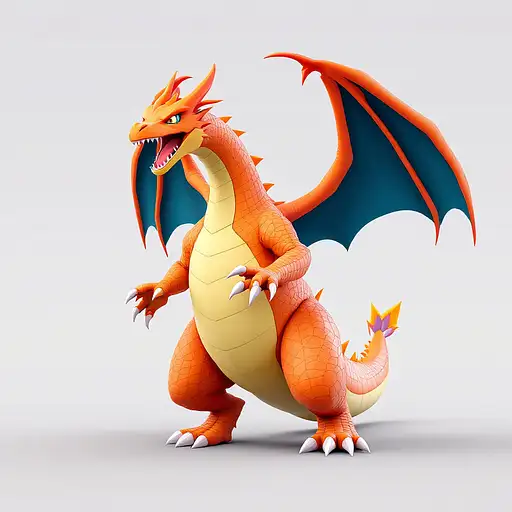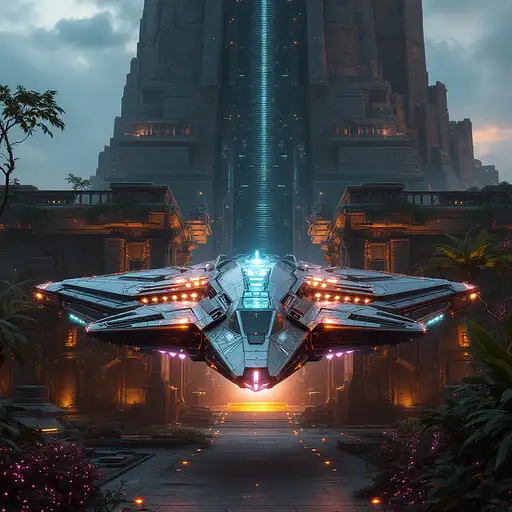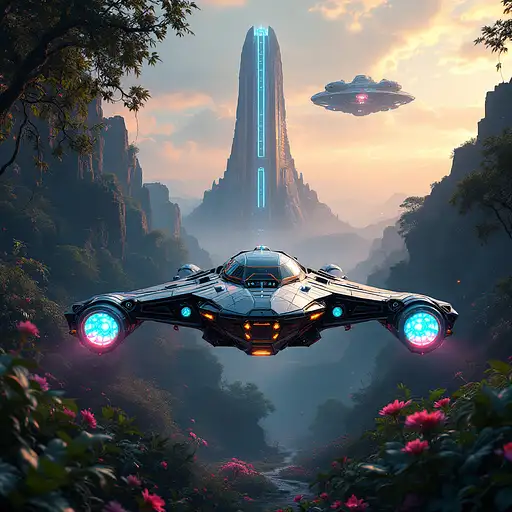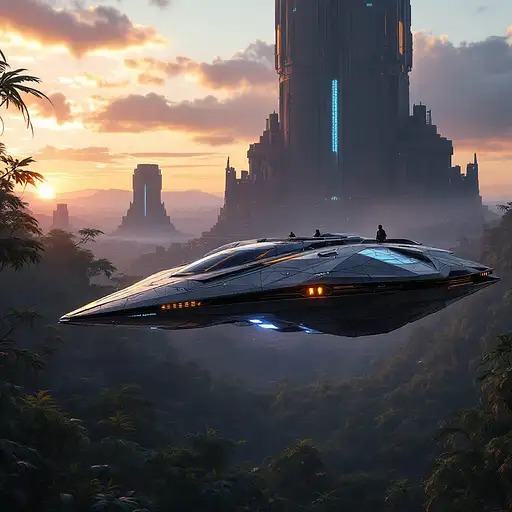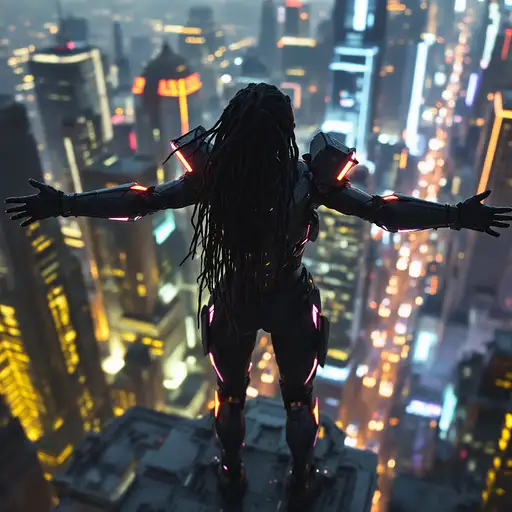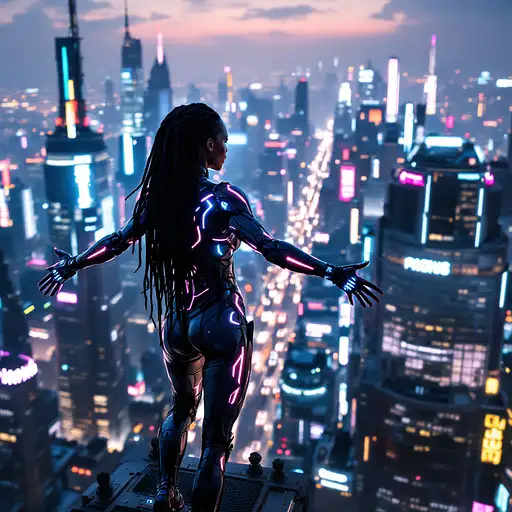7 months ago
In a 3D interpretation, **Charizard** takes on a vivid, dynamic form that showcases both its immense strength and graceful fluidity. The detailed modeling of Charizard in 3D allows for a fully realized view of the Pokémon from all angles, showcasing the intricacies of its body structure, texture, and movement in a visually engaging way. Here’s a breakdown of Charizard in a 3D definition:
### **Overall Structure and Proportions:**
Charizard stands tall in a bipedal stance with a broad, muscular body that exudes both power and agility. The 3D model accentuates the depth and breadth of its frame, highlighting its strong, reptilian build. The overall proportions emphasize the muscularity of its limbs, chest, and tail, with a pronounced curvature of its back, enhancing the creature's fierce posture. The wings are massive, extending from its back and designed to give the impression that Charizard could take flight at any moment, creating a sense of anticipation.
The model uses **smooth surface shading** and **subsurface scattering** techniques to make its scaly texture appear lifelike. With intricate shading and shadow details, every feature of Charizard comes to life, from the fine lines of its scales to the glow of its fiery tail.
### **Head and Facial Details:**
In 3D, Charizard’s head is fully sculpted, with an exaggerated sense of depth and dimension. The angular structure of the skull gives it a predatory look, with prominent ridges running along its brow and jawline. **The eyes** are highly expressive, with gleaming orange irises and slit pupils that capture the character's intense, fiery spirit. Using **ambient occlusion** and **reflection mapping**, the eyes gleam, reflecting ambient light around it, making them stand out with realistic depth and vibrancy.
The **horns** protruding from Charizard’s head are crafted with detailed ridges and surface imperfections, making them look rough yet regal, as if they’ve been shaped and weathered over time. The **snout** is defined by sharp edges and subtle curves, with noticeable nostrils that slightly flare with each breath. Charizard’s mouth, when open, reveals **sharp, jagged teeth** and a deep, threatening throat—built for fire-breathing and battle.
### **Body and Musculature:**
The body is a showcase of strength and agility, with **muscle groups** subtly highlighted through realistic lighting and texture maps. The **scales** on Charizard’s body are painted in a gradient of fiery oranges and reds, giving it a glowing, dynamic look. The texture mapping of the scales is highly detailed, with bumps and ridges that are apparent on the surface. These **normal maps** give the 3D model an ultra-realistic, tactile feel, making it appear like Charizard’s scales could be felt if touched.
From its wide, broad chest to its powerful legs, every muscle is emphasized. The **limbs** are sculpted with strong, flexible joints, showcasing Charizard’s ability to move swiftly. You can almost feel the tension and power in its legs as it prepares to take flight, with slight bulges at the joints and a natural look of readiness.
### **Wings:**
Charizard’s **wings** are one of the most striking aspects of the 3D model. They extend outward from its back with large, leathery, bat-like membranes. The **wing bones** are clearly visible, and the skin stretched between them shows a finely detailed texture, with veins and small imperfections that make the wings appear both functional and natural. The edges of the wings are slightly tattered, giving them the appearance of a battle-worn warrior.
In motion, the wings display fluid, lifelike movement, with the **muscles** beneath them flexing as if they were capable of propelling Charizard through the sky. When the wings are spread, the subtle **transparency** of the membrane allows light to pass through, adding a level of realism and visual depth.
### **Tail and Flame:**
The **tail** in 3D is long, muscular, and dynamic. It sways naturally with every movement, and the texture of the skin along the tail is carefully designed to reflect the different states of fire that Charizard can emit. The **flame** at the end of the tail is a blazing, unpredictable feature. It flickers and dances with realism, simulating the flow of fire, with real-time lighting effects and fluid dynamics that give the flame its motion.
Using advanced **particle effects**, the tail flame appears as though it’s alive, glowing and interacting with the environment. The flame’s color transitions from deep red to orange and yellow, creating a mesmerizing effect as it pulses and crackles with energy. The heat radiates off the tail, subtly distorting the air around it, which adds an additional layer of realism to the 3D model.
### **Claws and Feet:**
Charizard’s feet are robust, with **three sharp claws** on each limb. The claws themselves have been carefully modeled with **reflective surfaces** to make them look metallic, hinting at their strength and sharpness. The **scales** that cover Charizard’s feet are also very detailed, with bumps, cracks, and imperfections that make the feet look rugged, strong, and battle-hardened. Each toe is well-defined and positioned in a way that suggests both stability and power.
The **pads** on the feet, though rough and textured, would provide Charizard with a solid grip, enabling it to perch securely or move swiftly on various surfaces.
### **Texture and Shading:**
The entire 3D model is enhanced by advanced **shading techniques** like subsurface scattering, which allows light to pass through and reflect off the skin of Charizard, making it appear as though it is made of real, living tissue. The **specular highlights** on Charizard’s scales create an almost wet look, as if it has just been through a battle or flight, and subtle **bump maps** add depth to its skin and wings, providing tactile feedback for the viewer’s eye.
Additionally, Charizard’s **dynamic lighting** adds a cinematic touch to the 3D model, casting realistic shadows on the ground and nearby objects. The reflective surfaces of the wings, claws, and tail flame give off various light intensities, depending on the surrounding environment.
### **Movement and Animation:**
When animated, Charizard moves with an elegant yet predatory grace. The **movement of its wings** during flight is fluid and realistic, capturing the force needed to keep a creature of its size airborne. The muscles along its body ripple and shift with each step, showcasing both the grace of flight and the strength of land-based movements. The **tail** sways and flicks, reacting to the creature’s movements, while the **head** turns and tilts, exhibiting a level of expression that suggests intelligence and awareness.
### **Overall Presence in 3D:**
The entire 3D model of Charizard is a **visually immersive experience**, showcasing the Pokémon’s magnificence and power from every angle. The ability to rotate around the model allows you to appreciate every subtle detail, from the veins on its wings to the flickering of its fiery tail. Charizard, in 3D, is not just a character; it’s an experience. The model comes to life in a way that shows off its intimidating size, its majestic form, and the fierce spirit that burns inside it. Whether it’s preparing for flight, readying for battle, or simply resting, Charizard in 3D is an awe-inspiring creature that captures the full breadth of its fiery might, 8k, intricate detail, photorealistic, realistic light, wide angle, kinkfolk photography, A+D architecture





